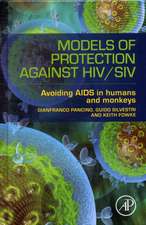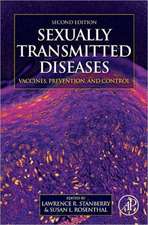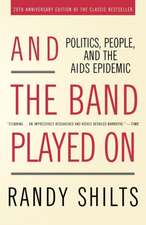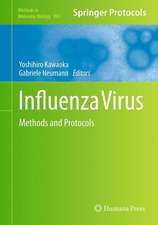Cancers in People with HIV and AIDS: Progress and Challenges
Editat de Robert Yarchoanen Limba Engleză Paperback – 2 sep 2016
In recent years, there has been a vast increase in our understanding of HIV-associated cancers. We now know, for example, that most are caused by other viruses and that the main role of HIV and immunodeficiency is to provide a supportive environment for the viruses to multiply and for the cancers to develop. But there remain a number of unanswered questions and a need for improved prevention and therapy. In the 28 chapters of this book, written by some of the most renowned experts in this field, we present up-to-date information on the cancers associated with HIV infection. The chapters cover the epidemiology of these cancers, their pathogenesis, their clinical presentation, and their treatment. The book will be of value to physicians, other medical professionals, students, and researchers with an interest in AIDS, viral-associated cancers, or HIV-associated malignancies.
TABLE OF CONTENTS
1. HIV-associated Cancers: Overview
Robert Yarchoan, Thomas Uldrick, Mark Polizotto
2. Epidemiology of AIDS-defining Malignancies
William A. Blattner and Rebecca G. Nowak
3. Epidemiology of non-AIDS Defining Malignancies
Andrew E. Grulich
4. HIV Cancers in Resource-Limited Regions
Sam M. Mbulaiteye
5. Kaposi's Sarcoma-associated Herpesvirus (KSHV)
Blossom Damania and Dirk P. Dittmer
6. Epstein Barr Virus (EBV)
Lindsey Hutt-Fletcher
7. Human Papillomavirus (HPV)
Zhi-Ming Zheng
8. Merkel Cell Polymavirus (MCV)
Nicole Fischer and Adam Grundhoff
9. Presentation and Pathogenesis of Kaposi's Sarcoma
Corey Casper
10. Management of Kaposi's Sarcoma
Susan E. Krown
11. Presentation and Pathogenesis of HIV Lymphomas
Richard F. Little, Stefania Pittaluga, Kieron Dunleavy
12. Diffuse Large B-Cell Lymphoma
Neel K. Gupta and Lawrence D. Kaplan
13. Burkitt and Burkitt-Like Lymphoma
Kishor Bhatia and Sam M. Mbulaiteye
14. Primary Effusion Lymphoma
Giovanna Tosato
15. AIDS-related Central Nervous System Lymphoma
Jan Davidson-Moncada and Thomas Uldrick
16. Plasmablastic and Other Lymphomas
Huan-You Wang, Ida Wong-Sefidan, Erin Reid
17. Hodkin Lymphoma
Michele Spina, Rosanna Ciancia, Accursio Augello
18. Multicentric Castelman Disease
Mark N. Polizzotto, Thomas S. Uldrick, Robert Yarchoan
19. Cervical Cancer
Elizabeth A. Stier
20. Anal Cancer
Joel Palefsky
21. Other HPV-Associated Cancers
Kristina R. Dahlstrom and Erich M. Sturgis
22. Lung Cancer in HIV Infection
Deepthi Mani and David M. Aboulafia
23. Hepattocellular Carcinoma in HIV-positive Patients
Massimiliano Berretta, Paolo De Paoli, Umberto Tirelli, Bruno Cacopardo
24. Merkel Cell Carcinoma and Other HIV-associated Skin Cancers
Nathalie C. Zeitouni adn Bethany Lema
25. Conjuctival Carcinoma
Kenneth O. Simbiri and Erle S. Robertson
26. Malignancies in Children with HIV Infection
D. Cristina Stefan
27. cART and Supportive Care
Ronald T. Mitsuyasu
28. Stem Cell Transplantation
Christine Durand and Richard Ambinder
| Toate formatele și edițiile | Preț | Express |
|---|---|---|
| Paperback (1) | 1100.30 lei 6-8 săpt. | |
| Springer – 2 sep 2016 | 1100.30 lei 6-8 săpt. | |
| Hardback (1) | 1107.41 lei 6-8 săpt. | |
| Springer – 10 iul 2014 | 1107.41 lei 6-8 săpt. |
Preț: 1100.30 lei
Preț vechi: 1158.20 lei
-5% Nou
Puncte Express: 1650
Preț estimativ în valută:
210.57€ • 228.65$ • 176.88£
210.57€ • 228.65$ • 176.88£
Carte tipărită la comandă
Livrare economică 22 aprilie-06 mai
Preluare comenzi: 021 569.72.76
Specificații
ISBN-13: 9781493955428
ISBN-10: 149395542X
Pagini: 405
Ilustrații: XVI, 389 p. 34 illus., 20 illus. in color.
Dimensiuni: 155 x 235 x 21 mm
Greutate: 0.57 kg
Ediția:Softcover reprint of the original 1st ed. 2014
Editura: Springer
Colecția Springer
Locul publicării:New York, NY, United States
ISBN-10: 149395542X
Pagini: 405
Ilustrații: XVI, 389 p. 34 illus., 20 illus. in color.
Dimensiuni: 155 x 235 x 21 mm
Greutate: 0.57 kg
Ediția:Softcover reprint of the original 1st ed. 2014
Editura: Springer
Colecția Springer
Locul publicării:New York, NY, United States
Cuprins
1. HIV-associated Cancers: Overview
Robert Yarchoan, Thomas Uldrick, Mark Polizotto
2. Epidemiology of AIDS-defining Malignancies
William A. Blattner and Rebecca G. Nowak
3. Epidemiology of non-AIDS Defining Malignancies
Andrew E. Grulich
4. HIV Cancers in Resource-Limited Regions
Sam M. Mbulaiteye
5. Kaposi's Sarcoma-associated Herpesvirus (KSHV)
Blossom Damania and Dirk P. Dittmer
6. Epstein Barr Virus (EBV)
Lindsey Hutt-Fletcher
7. Human Papillomavirus (HPV)
Zhi-Ming Zheng
8. Merkel Cell Polymavirus (MCV)
Nicole Fischer and Adam Grundhoff
9. Presentation and Pathogenesis of Kaposi's Sarcoma
Corey Casper
10. Management of Kaposi's Sarcoma
Susan E. Krown
11. Presentation and Pathogenesis of HIV Lymphomas
Richard F. Little, Stefania Pittaluga, Kieron Dunleavy
12. Diffuse Large B-Cell Lymphoma
Neel K. Gupta and Lawrence D. Kaplan
13. Burkitt and Burkitt-Like Lymphoma
Kishor Bhatia and Sam M. Mbulaiteye
14. Primary Effusion Lymphoma
Giovanna Tosato
15. AIDS-related Central Nervous System Lymphoma
Jan Davidson-Moncada and Thomas Uldrick
16. Plasmablastic and Other Lymphomas
Huan-You Wang, Ida Wong-Sefidan, Erin Reid
17. Hodkin Lymphoma
Michele Spina, Rosanna Ciancia, Accursio Augello
18. Multicentric Castelman Disease
Mark N. Polizzotto, Thomas S. Uldrick, Robert Yarchoan
19. Cervical Cancer
Elizabeth A. Stier
20. Anal Cancer
Joel Palefsky
21. Other HPV-Associated Cancers
Kristina R. Dahlstrom and Erich M. Sturgis
22. Lung Cancer in HIV Infection
Deepthi Mani and David M. Aboulafia
23. Hepattocellular Carcinoma in HIV-positive Patients
Massimiliano Berretta, Paolo De Paoli, Umberto Tirelli, Bruno Cacopardo
24. Merkel Cell Carcinoma and Other HIV-associated Skin Cancers
Nathalie C. Zeitouni adn Bethany Lema
25. Conjuctival Carcinoma
Kenneth O. Simbiri and Erle S. Robertson
26. Malignancies in Children with HIV Infection
D. Cristina Stefan
27. cART and Supportive Care
Ronald T. Mitsuyasu
28. Stem Cell Transplantation
Christine Durand and Richard Ambinder
Robert Yarchoan, Thomas Uldrick, Mark Polizotto
2. Epidemiology of AIDS-defining Malignancies
William A. Blattner and Rebecca G. Nowak
3. Epidemiology of non-AIDS Defining Malignancies
Andrew E. Grulich
4. HIV Cancers in Resource-Limited Regions
Sam M. Mbulaiteye
5. Kaposi's Sarcoma-associated Herpesvirus (KSHV)
Blossom Damania and Dirk P. Dittmer
6. Epstein Barr Virus (EBV)
Lindsey Hutt-Fletcher
7. Human Papillomavirus (HPV)
Zhi-Ming Zheng
8. Merkel Cell Polymavirus (MCV)
Nicole Fischer and Adam Grundhoff
9. Presentation and Pathogenesis of Kaposi's Sarcoma
Corey Casper
10. Management of Kaposi's Sarcoma
Susan E. Krown
11. Presentation and Pathogenesis of HIV Lymphomas
Richard F. Little, Stefania Pittaluga, Kieron Dunleavy
12. Diffuse Large B-Cell Lymphoma
Neel K. Gupta and Lawrence D. Kaplan
13. Burkitt and Burkitt-Like Lymphoma
Kishor Bhatia and Sam M. Mbulaiteye
14. Primary Effusion Lymphoma
Giovanna Tosato
15. AIDS-related Central Nervous System Lymphoma
Jan Davidson-Moncada and Thomas Uldrick
16. Plasmablastic and Other Lymphomas
Huan-You Wang, Ida Wong-Sefidan, Erin Reid
17. Hodkin Lymphoma
Michele Spina, Rosanna Ciancia, Accursio Augello
18. Multicentric Castelman Disease
Mark N. Polizzotto, Thomas S. Uldrick, Robert Yarchoan
19. Cervical Cancer
Elizabeth A. Stier
20. Anal Cancer
Joel Palefsky
21. Other HPV-Associated Cancers
Kristina R. Dahlstrom and Erich M. Sturgis
22. Lung Cancer in HIV Infection
Deepthi Mani and David M. Aboulafia
23. Hepattocellular Carcinoma in HIV-positive Patients
Massimiliano Berretta, Paolo De Paoli, Umberto Tirelli, Bruno Cacopardo
24. Merkel Cell Carcinoma and Other HIV-associated Skin Cancers
Nathalie C. Zeitouni adn Bethany Lema
25. Conjuctival Carcinoma
Kenneth O. Simbiri and Erle S. Robertson
26. Malignancies in Children with HIV Infection
D. Cristina Stefan
27. cART and Supportive Care
Ronald T. Mitsuyasu
28. Stem Cell Transplantation
Christine Durand and Richard Ambinder
Recenzii
From the book reviews:
“This book aims to provide a comprehensive understanding of the various mechanisms of oncogenesis in HIV patients and to focus upon the prevention, diagnosis, and management of a broad array of HIV-related malignancies. … The audience includes students, residents, practitioners, and professors in the medical community. This is an appropriate audience. The authors are experts in their respective fields and do an excellent job of conveying complex information in an accessible manner.” (Joseph C. Alvarnas, Doody’s Book Reviews, October, 2014)
“This book aims to provide a comprehensive understanding of the various mechanisms of oncogenesis in HIV patients and to focus upon the prevention, diagnosis, and management of a broad array of HIV-related malignancies. … The audience includes students, residents, practitioners, and professors in the medical community. This is an appropriate audience. The authors are experts in their respective fields and do an excellent job of conveying complex information in an accessible manner.” (Joseph C. Alvarnas, Doody’s Book Reviews, October, 2014)
Textul de pe ultima copertă
The association between AIDS and cancer was recognized from the beginning ofthe AIDS epidemic, when the appearance of Kaposi sarcoma in a cluster of youngmen was one of the first signs of this new disease. It was soon recognized that AIDSpatients are prone to develop a number of “AIDS-defining” cancers: Kaposi sarcoma,lymphoma, and cervical cancer. The development of effective combination anti-HIVtherapy starting around 1996 converted AIDS from a death sentence to a manageabledisease and led to dramatic shifts in the epidemic. As this therapy was able to improveimmune function in patients, the incidence of most “AIDS-defining” cancers decreased.There is a misconception, however, that AIDS has gone away. In fact, as AIDS patientsare living longer, the number of AIDS patients has more than doubled in the UnitedStates since 1996, and the AIDS population overall has increased in age. Also, as AIDSpatients are less likely to die of other complications, cancer is coming to the forefront as one of the most common causes of death in regions where AIDS drugs are widelyavailable.Moreover, the three “AIDS-defining” cancers are now taking a back seat toa number of other HIV-associated cancers, such as Hodgkin lymphoma, lung cancer,and anal cancer. In the developing world, AIDS-associated cancers are a major publichealth problem, and in some regions of sub-Saharan Africa, Kaposi sarcoma is themost common tumor in men.
In recent years, there has been a vast increase in our understanding of HIV-associatedcancers. We now know, for example, that most are caused by other viruses and thatthe main role of HIV and immunodeficiency is to provide a supportive environmentfor the viruses to multiply and for the cancers to develop. But there remain a numberof unanswered questions and a need for improved prevention and therapy. In the 28chapters of this book, written by some of the most renowned experts in this field, wepresent up-to-date information on the cancers associated with HIV infection. Thechapters cover the epidemiology of these cancers, as well as their pathogenesis, clinicalpresentation, and treatment.
Dr. Robert Yarchoanis the Director of the Office of HIV and AIDS Malignancy andChief of the HIV and AIDS Malignancy Branch in the National Cancer Institute. Heplayed a major role in developing the first AIDS drugs. His research is now focused onAIDS-related cancers, especially Kaposi sarcoma and other cancers caused by Kaposisarcoma-associated herpesvirus.
In recent years, there has been a vast increase in our understanding of HIV-associatedcancers. We now know, for example, that most are caused by other viruses and thatthe main role of HIV and immunodeficiency is to provide a supportive environmentfor the viruses to multiply and for the cancers to develop. But there remain a numberof unanswered questions and a need for improved prevention and therapy. In the 28chapters of this book, written by some of the most renowned experts in this field, wepresent up-to-date information on the cancers associated with HIV infection. Thechapters cover the epidemiology of these cancers, as well as their pathogenesis, clinicalpresentation, and treatment.
Dr. Robert Yarchoanis the Director of the Office of HIV and AIDS Malignancy andChief of the HIV and AIDS Malignancy Branch in the National Cancer Institute. Heplayed a major role in developing the first AIDS drugs. His research is now focused onAIDS-related cancers, especially Kaposi sarcoma and other cancers caused by Kaposisarcoma-associated herpesvirus.
Caracteristici
Fills a hitherto under-represented niche in HIV/AIDS research
Presents up-to-date information on the cancers associated with HIV infection
Addresses the misconception that HIV and AIDS are no longer severe health concerns
Includes supplementary material: sn.pub/extras
Presents up-to-date information on the cancers associated with HIV infection
Addresses the misconception that HIV and AIDS are no longer severe health concerns
Includes supplementary material: sn.pub/extras








